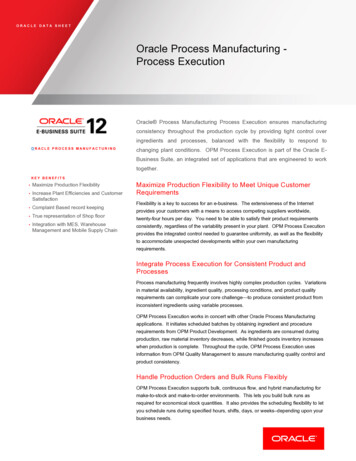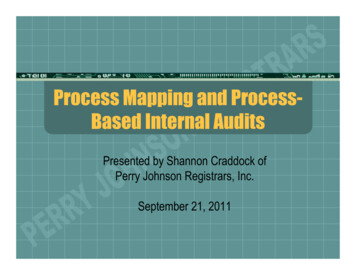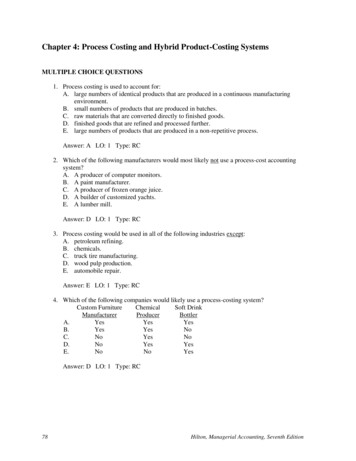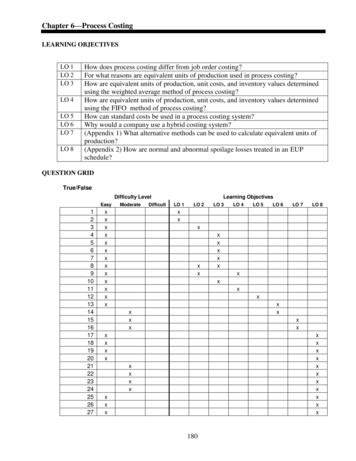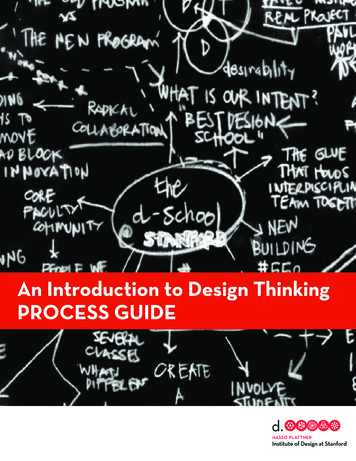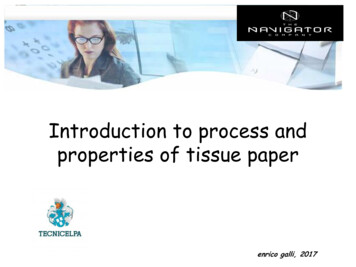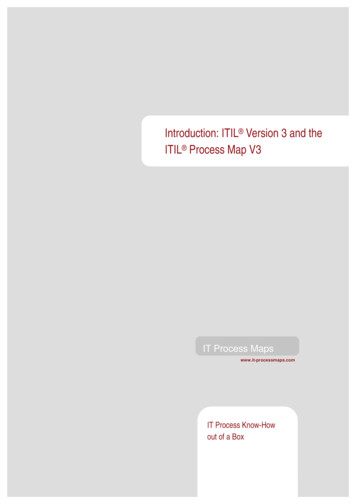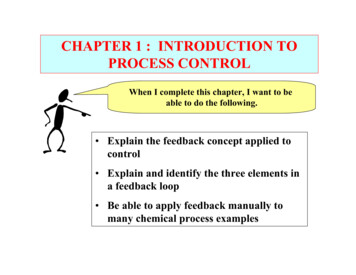
Transcription
CHAPTER 1 : INTRODUCTION TOPROCESS CONTROLWhen I complete this chapter, I want to beable to do the following. Explain the feedback concept applied tocontrol Explain and identify the three elements ina feedback loop Be able to apply feedback manually tomany chemical process examples
CHAPTER 1 : INTRODUCTION TOPROCESS CONTROLOutline of the lesson. Why Process Control and Why Now? Basic Questions about Control- What does a feedback system do?- Why is control necessary?- Why is control possible?- Where is control done?- How is control documented? Workshop Self-Study Guides
WHY HAVE A PROCESS CONTROL COURSE? When I run a kinetics experiment, how do Imaintain the temperature and level at desiredvalues? How do I manufacture products with consistentlyhigh quality when raw material propertieschange? How much time do I have to respond to adangerous situation?Every engineer needs basic knowledge about control.Many exciting career opportunities exist for atechnical specialist.
WHY NOW FOR THE CONTROL COURSE? We started with steady-state analysis because it iseasier and important. We are building expertise in fundamentals (fluids,heat transfer, thermo, etc.) and process units(distillation, CSTR, etc.). Now we have examplesthat need control! We need to master control before integrating ourknowledge in process design?It’s a perfect time to learn how to “drive” the chemicalprocess. With this insight, we will be able to design plantsthat can be controlled safely and produce high quality products.
WHAT DOES A FEEDBACK SYSTEM DO?Let’s look at a few examples first. Then, we willdevelop a general concept. Describe your methodfor driving a car. Could you drive a carwithout looking outthe windshield? What must beprovided by the cardesigner? Can a “good design”eliminate the need tosteer?
WHAT DOES A FEEDBACK SYSTEM DO?Let’s look at a few examples first. Then, we willdevelop a general concept. Describe how homeheating works. Describe the dynamicbehavior of T. What must beprovided by the housedesigner? Can a “good design”eliminate the need tochange the heating?
WHAT DOES A FEEDBACK SYSTEM DO?Why does the temperature cycle?Is this good enough for all variables in a chemicalprocess? Hint: if “yes”, the course is over!
WHAT DOES A FEEDBACK SYSTEM DO?The control systems appear to have three basic elements.Desired uts
WHAT DOES A FEEDBACK SYSTEM DO?What is a typical “final element” forchemical processes?Desired utsHow do we select the sensorlocation?What is the meaningof the arrows?
WHAT DOES A FEEDBACK SYSTEM DO?Desired utsCONTROL (verb): To maintain desired conditions in aphysical system by adjusting selected variables in the system.FEEDBACK CONTROL makes use of an output of a systemto influence an input to the same system.input causeoutput effect
WHAT DOES A FEEDBACK SYSTEM DO?Caution: Common misunderstanding in terminology!
WHAT DOES A FEEDBACK SYSTEM DO?Caution: Common misunderstanding in terminology!Common vernacularNegative feedback: “Youare an idiot!Positive feedback: That wasa good idea. Thank you!
WHAT DOES A FEEDBACK SYSTEM DO?Caution: Common misunderstanding in terminology!Common vernacularEngineering & ScienceNegative feedback: “Youare an idiot!Negative feedback: Actionto reduce the error fromdesired.Positive feedback: That wasa good idea. Thank you!Positive feedback: Action toincrease the error fromdesired.
WHAT DOES A FEEDBACK SYSTEM DO?Caution: Common misunderstanding in terminology!Common vernacularEngineering & ScienceNegative feedback: “Youare an idiot!Negative feedback: Actionto reduce the error fromdesired.Good!Positive feedback: That wasa good idea. Thank you!Positive feedback: Action toincrease the error fromdesired.
WHY IS CONTROL NECESSARY?One word: DISTURBANCES! Give someexamples in the CSTR in the figure.v1TACBv2We want to achieve thefollowing:1. Safety2. Environmental Protect.3. Equipment protect.4. Smooth operation5. Product quality6. Profit7. Monitoring and diagnosisChapter 2
WHY IS CONTROL NECESSARY?xDFROne word:DISTURBANCES!Give some examplesin the distillationtower in the figure.FVxB
WHY IS CONTROL POSSIBLE?Control is possible only if the engineer providesthe required equipment during process design.Part 1: Control tingand interfacefor personCBv2Final element
WHY IS CONTROL POSSIBLE?Control is possible only if the engineer providesthe required equipment during process design.Part 2: Process equipmentv1How do wedeterminethe reactorvolume?TACBv2How do we determinethe heat transfer area?
WHERE IS CONTROL DONE?Sensors, localindicators, andvalves in the processDisplays of variables,calculations, and commandsto valves are in thecentralized control center.Shows an older-stylecontrol panel
WHERE IS CONTROL DONE?Central control roomSensors, localindicators, andvalves in the processDisplays of variables,calculations, and commandsto valves are in thecentralized control center.Shows a modern, computerbased control panel
HOW IS CONTROL DESIGN DOCUMENTED?Piping and instrumentation (P&I) drawings providedocumentation. The system is too complex to describe in text. We must use standard symbols.FCF flowL levelTCALCP pressureT temperature .
CHAPTER 1: INTRODUCTION - WORKSHOP 1You are implementingcontrol “manually”.Flow Controla. Explain the principlefor a typical flowsensorb. Explain how the finalelement affects thecontrolled variable.c. Explain the correctaction if you want toincrease the controlledvariablesensorpumpvalve
CHAPTER 1: INTRODUCTION - WORKSHOP 2You are implementingcontrol “manually”.a. Explain the principlefor a typical liquidlevel sensorLevel Controlsensorb. Explain how the finalelement affects thecontrolled variable.c. Explain the correctaction if you want toincrease the controlledvariablepumpvalve
CHAPTER 1: INTRODUCTION - WORKSHOP 3You are selling a gas to a customer based on the volumetricflow at standard conditions. You decide to use an orificemeter to measure the flow rate.You have learned that the gas flow density may change by-10% from its design (expected) value. What do you do?Orifice meterOurplantCustomercompressorvalve
CHAPTER 1 : INTRO. TO PROCESS CONTROLHow are we doing? Explain the feedback concept applied tocontrol Explain and identify the three elements ina feedback loop Be able to apply feedback manually tomany chemical process examplesLot’s of improvement, but we need some more study! Read the textbook Review the notes, especially learning goals and workshop Try out the self-study suggestions Naturally, we’ll have an assignment!
CHAPTER 1: LEARNING RESOURCES SITE PC-EDUCATION WEB- Instrumentation Notes- Interactive Learning Module (Chapter 1)- Tutorials (Chapter 1/2) Textbook Appendix A on drawing symbols- See references for much more detail or symbols
CHAPTER 1:SUGGESTIONS FOR SELF-STUDY1. Write down the rules (algorithm) that you use when youdrive an automobile or bicycle.2. Formulate questions with answers and trade withmembers of your study group.3. Find a P&I drawing in one of the textbook references(or recent volume of Chemical Engineering Progress),explain the strategy, and prepare questions for yourinstructor on aspects that you do not understand.4. Find examples of control systems in your house. (Hint:look at the heating, air conditioning, toilet tank, and themost highly automated room, the kitchen.
CHAPTER 1 : INTRODUCTION TO PROCESS CONTROL When I complete this chapter, I want to be able to do the following. Explain the feedback concept applied to control Explain and identify the three elements in a feedback loop Be able to

